Tuscany Delicious
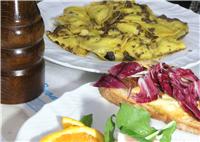
The wealth of the Tuscan region and its distinctive characteristics can all be tied in with the land. Its green hills yield abundant harvests of all sorts. As a result of it genuine ingredients, that are locally cultivated, are at base of age-old recipes. A holiday in Tuscany offers much more than a world-class art and fashion, but also great food and great wine!
Tuscan cooking today is characterized by simple food, not covered in heavy sauces. Cooking is done with olive oil-used as salad dressing, poured over bread, and in soups and stews. Beans are a staple. Sage, rosemary, thyme, and marjoram are popular herbs. The farmland produces olive oil and wine, wheat, and fruits. Chickens, ducks, rabbits, cows, and pigs are raised in small estates. The vegetables grown here include artichokes, asparagus, spinach, beans, and peas; and, a great number of wild mushrooms, including porcini and morels, is found.
The traditional dishes that are worth trying are many, and they are prepared as grandmothers did. So what are you waiting to try our recipes...
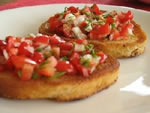
Bruschetta with Tomato and Basil
Bruschetta, the simplest of pleasures. When olive oil has just been pressed in the colder months all you need to do is toast some bread and rub some garlic over the top. Complete it using the newly pressed olive oil and you're done. One of the greatest "fast foods" you can treat yourself with.
In the summer with just one extra ingredient you get to paradise! With fresh red tomatoes and basil, bruschetta is just a perfect starter or a complete light meal.
Ingredients - Serve 6
6 medium-sized juicy red tomatoes
basil leaves, ripped
extra virgin olive oil
6 large slices of tuscan salt less bread (or your favourite bread)
1 or more garlic clove, peeled
Preparation
Dice the tomatoes and put them into a bowl. Add the basil and season with salt. Mix through about 3 table spoons of extra virgin olive oil.
Grill the bread slices on both sides and rub one side of each with the whole garlic clove, some choose to dice the garlic and mix it with the tomatoes, it's your choice. Cover with the tomato mix and if you like add some more olive oil.
Variation
This basic recipe works as the perfect canvas for other toppings. Try a few basic recipe to build your confidence, experiment with a few of the more creative variations and soon you'll be coming up with your own favourite toppings to wow your guests. Bruschetta with ham: Prepare bread as above and just top with a slice of ham
Bruschetta with mozzarella: Add to the basic recipe grated mozzarella
Bruschetta with olives: Add to the basic recipe olives and cappers
Bruschetta with beans: Prepare bread as above and just top with cannellini beans
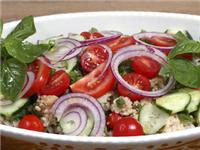
Panzanella
This very mediterranean salad is another example of genuine Italian cuisine. The record of panzanella goes back centuries. In the 1500s, a poem by the famous artist Bronzino described the salad. Of course, the tomato was quite a few years from being introduced into the Italian kitchen, so the ingredients were limited to cucumber, onion, basil, arugula, and bread.
You need a salt-free bread for panzanella. Some of the great new breads from artisan bakeries work well. (Florentines produce their bread without salt, which is balanced off with a heavy hand with salt in their dishes.) It's important to use a bread that actually goes stale. Slice the bread thickly and let it dry. It needs to crumble after moistening, not form bread balls. Its texture when crumbled should resemble couscous. In fact, try substituting couscous for bread the second time you make this recipe.
In addition to panzanella, the Florentines have created several recipes that recycle stale bread. The most famous are ribollita, vegetable soup reboiled with bread, and Pappa al pomodoro, the tomato version.
Ingredients
1 pound stale bread
3 tomatoes, cut into pieces
2 red onions, thinly slices
1 cucumber, peeled and sliced
Basil
Olive oil
Vinegar
Salt
Preparation
Soak the sliced stale bread in cold water for 10 minutes. Squeeze out the water and crumble the bread into a serving bowl. Add tomatoes, cucumber, onions and basil. Season will olive oil and salt. Mix well and let sit. Before serving, add vinegar and mix again. Serve with olive oil, vinegar, and salt on the side.
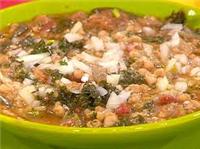
Ribollita
Tuscan cuisine is famous for giving new life to leftovers. This dish is a perfect example. An icon of Tuscan cuisine, ribollita literally means "reboiled. Minestrone (traditional vegetables soup) is made the first day and eaten as it is. The second day the leftover soup is layered with thin slices of bread (or toasted bread rubbed with garlic) and baked with thin slices of red onion on top. The third day the leftovers are reboiled.
Recipes for minestrone vary from region to region, restaurant to restaurant, and household to household. Most recipes are based upon regional produce. The most important ingredient in Tuscan minestrone is cavolo nero, or a winter black cabbage. Its leaves range in colour from dark green to almost black. Once grown only in Tuscany, enterprising farmers are now growing it in California. If you cannot find black cabbage, substitute kale, chard, or use only Savoy cabbage.
Ingredients
4 tablespoons olive oil
1 red onion, chopped
1 leek, white part only, chopped
1 garlic clove, chopped
4 carrots, sliced into half-inch rounds
4 zucchini, sliced into half-inch rounds
One-quarter whole Savoy cabbage, shredded and chopped
1 bunch cavolo nero or kale
1 small bunch spinach, shredded and chopped
4 potatoes, peeled and cut into one-half inch cubes
1 cup green beans, cut into bite-size pieces
2 cups Tuscan white beans
2 tablespoons sea salt
4 tablespoons tomato paste
1 pound stale Italian bread, sliced
Preparation
Heat the olive oil in a large pot and sauté the onion and leek together over low heat until they begin to burn slightly. Add the garlic and sauté for 1 minute. Add all the remaining vegetables. Season with sea salt and stir to mix in the onions and leeks evenly. Cover and cook for 20 minutes or until the vegetables have reduced in volume by half. Stir again and cover with water to the top of the pot. The more water you add, the more broth you will have with the soup. Bring to a boil and then lower the heat. Add the tomato paste and stir to dissolve. Cover and cook the soup for 1 hour. Add the Tuscan beans.
This is the minestrone soup. The next day layer the soup in a deep baking dish with the stale bread and bake. Top with thinly sliced red onions before baking.
The next day, if there's any soup left over, reboil the soup, stirring well to break up the bread slices. The soup should be thick enough to eat with a fork! It's served with the traditional drizzle of extra virgin olive oil on top.
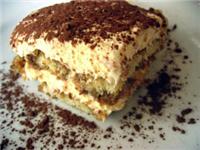
Tiramisu Desert
Tiramisu' means "pick-me-up" in Italian, for the high energetic content (eggs and sugar) and the caffeine of the strong espresso coffee. There are many different stories about the origin of Tiramisu'. It is a layered cake; therefore some people place its origin in Tuscany, where another famous layered Italian dessert is very popular. It is called "Zuppa Inglese" (English Soup). It is not English and it is not a soup. Instead is a simple cake of ladyfingers or sponge cake, soaked in "alkermes" liquor, and alternated layers of chocolate and egg custard. Layered cakes have been around for long time. The brilliant idea in Tiramisu' is not in the technique of layering, but in the components. The great invention of combining together coffee, zabaglione cream, and chocolate: This is the true innovation in Tiramisu'.
Ingredients - Serve 6
3 large eggs, separated
3 tbs fine sugar
250 g mascarpone cheese
2 tbs of a coffee liqueur or marsala
500 ml coffee
200 g pavesini or lady finger coookies
Cocoa powder
Preparation
With an electric mixer, beat the egg yokes and sugar until the mixture is thick and pale, Add the mascarpone and keep whisking. Mix in the coffee liqueur and set aside. In a large bowl, whisk the egg whites and a pinch of salt until firm. Using a spatula, gently fold them into the mascarpone mixture. Place the cold coffee in a shallow bowl. Dip the biscuits in the coffee then place them in the serving dish in a single layer. Pour the mascarpone mixture on top of the layer of biscuits. Place another layer of coffee-soaked biscuits on top and repeat the process until all biscuits have been used. The last layer of the Tiramisù is a layer of the mascarpone mixture. Cover the dish with cling film and chill for a few hours. Before serving, dust the Tiramisù with cocoa powder or freshly grated chocolate. The end result in a soft, creamy, dessert to be eaten with a spoon.